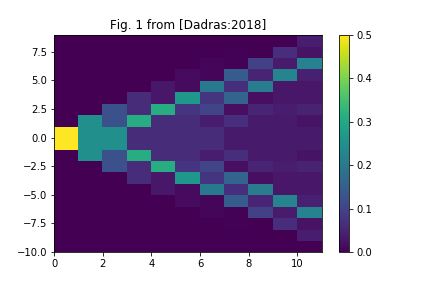
Quantum Random Walks¶
Here we demonstrate some simple code to explore quantum random walks. To play with this notebook, click on:
import mmf_setup; mmf_setup.nbinit()
Single Particle in a Box¶
We start with a model of a single particle in a periodic box (Section III.A from [Kempe:2003]). Equation numbers correspond to [Kempe:2003.] The wavefunction is then simply a vector on our set of $N$ abscissa. This wavefunction lives in our original Hilbert space $\mathcal{H}_P$ spanned by the basis of "position" eigenstates $\ket{n}$ such that $\abs{\braket{\psi|n}}^2$ is the probability that the particle is on the $n$th run of the ladder. $ \newcommand{\ua}{\uparrow} \newcommand{\da}{\downarrow} $ The full quantum random walk problem lives in an axuilliary Hilbert space $\mathcal{H} = \mathcal{H}_C\otimes \mathcal{H}_P$ where $\mathcal{H}_C$ is a two-dimensional Hilbert space spanned by two spin states $\ket{\ua}$, $\ket{\da}$. The idea here is that motion up the ladder corresponds with being in the spin state $\ket{\ua}$ while motion down the ladder corresponds to $\ket{\da}$. The unitary evolution operator is thus:
\begin{gather} \mat{S} = \ket{\ua}\bra{\ua}\otimes \sum_{n}\ket{n+1}\bra{n} + \ket{\da}\bra{\da}\otimes \sum_{n}\ket{n-1}\bra{n}. \tag{12} \end{gather}%pylab inline
from collections import namedtuple
def tprod(A, B):
"""Return the tensor product of A and B."""
dim = len(A.shape)
if dim == 1:
AB = np.einsum('a,i->ai', A, B)
elif len(A.shape) == 2:
AB = np.einsum('ab,ij->aibj', A, B)
else:
raise NotImplementedError
return AB.reshape(np.prod(AB.shape[:dim]),
np.prod(AB.shape[dim:]))
# Raise a matrix to a power
mpow = np.linalg.matrix_power
def apply(A, psi):
"""Return `A(psi)`, applying the operator A to psi."""
return A.dot(psi.ravel()).reshape(psi.shape)
def get_U(N=256):
"""Return the unitary evolution operators for an N site lattice."""
x = np.arange(N) - N//2
n = np.eye(N) # Position basis vectors
n_plus_1 = np.hstack([n[:, 1:], n[:, :1]])
n_minus_1 = np.hstack([n[:, -1:], n[:, :-1]])
ua, da = s = np.eye(2) # Spin basis vectors
S = (tprod(ua[:, None]*ua[None, :], n_plus_1.dot(n.T)) +
tprod(da[:, None]*da[None, :], n_minus_1.dot(n.T)))
# Hadamard coin (13)
C = np.array([[1, 1],
[1, -1]])/np.sqrt(2)
# Unbiased coin (17)
Y = np.array([[1, 1j],
[1j, 1]])/np.sqrt(2)
U_C = S.dot(tprod(C, np.eye(N)))
U_Y = S.dot(tprod(Y, np.eye(N)))
assert np.allclose(np.eye(2*N), S.dot(S.T.conj()))
assert np.allclose(np.eye(2*N), U_C.dot(U_C.T.conj()))
assert np.allclose(np.eye(2*N), U_Y.dot(U_Y.T.conj()))
Results = namedtuple('Results', ['N', 'x', 'U_C', 'U_Y'])
return Results(N=N, x=x, U_C=U_C, U_Y=U_Y)
Now we start from the state $\ket{\da}\otimes\ket{0}$ and evolve with the unitary evolution operator:
$$ \mat{U} = \mat{S}\cdot(\mat{C}\otimes\mat{1}). $$Doing this 100 times, we obtain Fig. 5 from [Kempe:2003].
res = get_U(N=200)
psi = np.zeros((2, res.N))
psi[1, res.N//2] = 1
psi_100 = apply(mpow(res.U_C, 100), psi)
# Plot only even indices as the odd sites are not occupied
# Note: this depends on the value of N chosen.
plt.plot(res.x[0::2], (abs(psi_100)**2).sum(axis=0)[0::2])
plt.axis([-80, 80, 0, 0.1])
plt.title("Fig. 5 from [Kempte:2003]")
Starting from a symmetric initial condition we obtain Fig. 6. (It appears they forgot to normalize the initial state properly.)
psi = np.zeros((2, res.N), dtype=complex)
psi[0, res.N//2] = 1 #/np.sqrt(2) # Kempte: seems to miss this normalization
psi[1, res.N//2] = 1j #/np.sqrt(2)
psi = apply(mpow(res.U_C, 100), psi)
# Plot only odd indices as the even sites are not occupied.
plt.plot(res.x[0::2], (abs(psi)**2).sum(axis=0)[0::2])
plt.axis([-100, 100, 0, 0.16])
plt.title("Fig. 5 from [Kempte:2003]")
MMF Note: Using the coin $Y$ from (17) does not seem to give symmetric evolution like they claim... not sure why.
psi = np.zeros((2, res.N), dtype=complex)
psi[1, res.N//2] = 1.0
psi_100 = apply(mpow(res.U_Y, 100), psi)
# Plot only odd indices as the even sites are not occupied
plt.plot(res.x[0::2], (abs(psi_100)**2).sum(axis=0)[0::2])
plt.axis([-80, 80, 0, 0.1])
Let's look at the evolution now, anticipating a comparison with [Dadras:2018].
res = get_U(N=20)
psi = np.zeros((2, res.N), dtype=complex)
psi[0, res.N//2] = 1/np.sqrt(2)
psi[1, res.N//2-1] = 1/np.sqrt(2)
psis = [psi]
Ts = np.arange(12)
for T in Ts[1:]:
psis.append(apply(res.U_C, psis[-1]))
psis = np.asarray(psis)
ns = (abs(psis)**2).sum(axis=1)
plt.pcolormesh(Ts, res.x, ns.T)
plt.colorbar()
plt.title("Fig. 1 from [Dadras:2018]")
plt.savefig("images/SymmetricQRW.png")
One can get a biased quantum walk by starting from a different initial state, or by using a different coin. In [Dadras:2018] they use a different coin. Try to reproduce their Fig. 2.
res = get_U(N=20)
psi = np.zeros((2, res.N), dtype=complex)
psi[0, res.N//2] = 1
psi[1, res.N//2-1] = 0
psis = [psi]
Ts = np.arange(12)
for T in Ts[1:]:
psis.append(apply(res.U_C, psis[-1]))
psis = np.asarray(psis)
ns = (abs(psis)**2).sum(axis=1)
plt.pcolormesh(Ts, res.x, ns.T)
plt.colorbar()
plt.title("Not quite Fig. 2 from [Dadras:2018]")